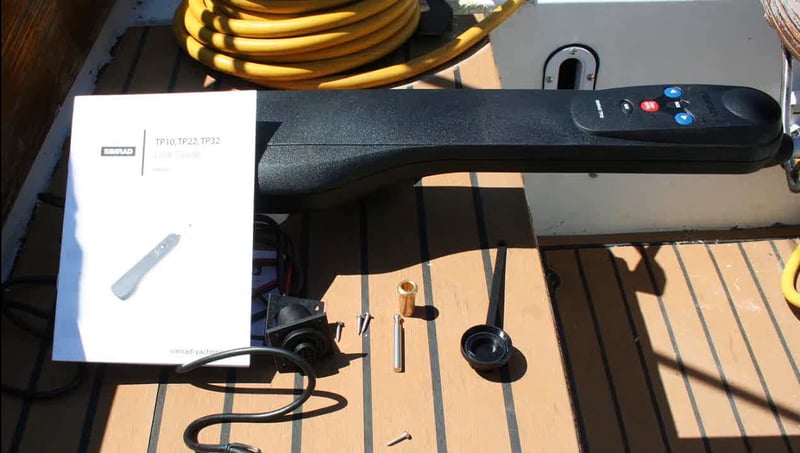
For shorthanded sailors, a good autohelm is like having an extra pair of hands on deck. But the cost of a full-blown instrument system can be prohibitive for many smaller boats. A tiller pilot offers a cost-effective solution for tiller steer boats up to 37ft in length, including ocean rowing boats.
The Simrad Tillerpilot is a sealed unit consisting of a powerful mechanical drive, an internal fluxgate compass and some clever electronics. There are 3 sizes in the range, with the 2 larger sizes including the option to connect to other instruments onboard via NMEA 0183 or Simrad’s SimNet bus system.
| Model | Typical max. boat size | Peak thrust | SimNet / NEMA 0183 compatible |
| TP10 |
32ft |
65kg |
No |
| TP22 |
34ft |
70kg |
Yes |
| TP32 |
37ft |
85kg |
Yes |
TP10
The TP10 is the smallest and simplest unit in the range. The pilot uses the internal compass to derive heading information for the vessel and steer to the desired input. For steady wind conditions or short periods during manoeuvres this will typically be more than adequate to keep the boat on a constant heading. The TP10 also features a Tack function which turns the vessel through 100° in the direction selected, allowing a solo sailor to leave the helm and tack the jib.
As the TP10 is not able to steer to wind, the performance is of course reduced when sailing in a shifty breeze. It is also worth noting that the internal compass can suffer interference from nearby magnetic fields. Particularly on ferrous-hulled boats it is worth upgrading to the larger TP22 connected to an external compass.
TP22 & TP32
The larger units in the range work on the same basic principles of the TP10 but with the additional option to connect to other onboard electronics via the SimNet high-speed bus or the in-built NEMA 0183 interface. When provided with wind & GPS data, the TP22 and TP32 can offer all the functionality of a permanently installed system.
Additional features include:
- Steer to wind
- Auto tacking & gybing
The pilot detects whether you are sailing upwind or downwind and will tack or gybe accordingly to bring the vessel to the same wind angle on the opposite tack - Steer to waypoint

Installation
Installation is straightforward and requires only basic DIY knowledge and tools. All Tillerpilots are powered by a 12V DC supply. The TP10 is supplied with open cable ends which can be wired directly to a power supply or to the waterproof bulkhead connector available separately. TP22 and TP32 include a cable and bulkhead connector which carries the power supply and data connection. The on-deck installation consists of a mounting cup to be inserted into the cockpit seat and a tillerpin on the tiller arm. Various accessories are available to allow different mounting configurations depending on the specifics of the boat. The Tillerpilot is pre-set for starboard mounting but can be re-configured for port side installation.
Conclusion
The Simrad Tillerpilot is a simple, affordable option to add an autohelm to a tiller steer boat. This can serve as your primary system for shorthanded sailing or as a backup standalone device in case of an outage with your permanently installed device.
If you have any questions about Simrad tiller pilots, please feel free to email us at support@upffront.com, or click the link below to see our full range:



